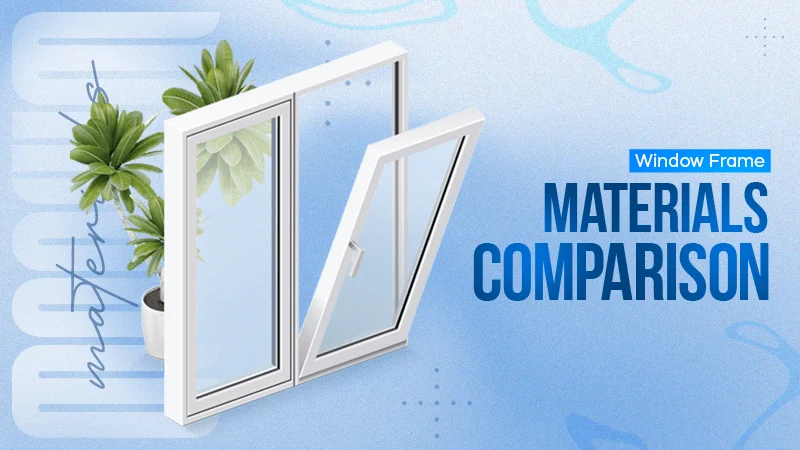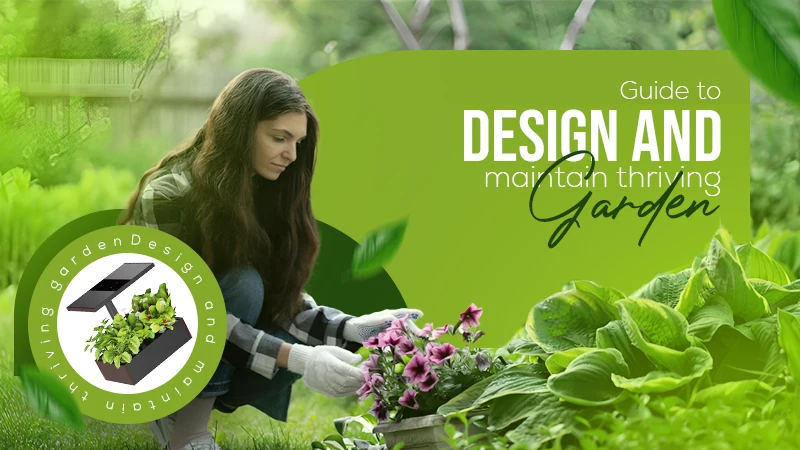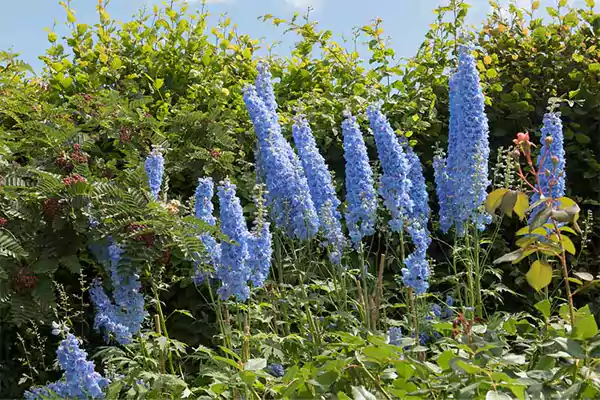
If you are looking to add a bit of elegance and drama to your balcony garden, Delphinium can be just the ideal addition. These tall perennials tend to become the show-stopper in any landscape. With stunning flowering spikes that add vertical beauty and come in a range of shades, growing these Delphinium plants can be a rewarding experience.
Though these species are beautiful, they do need a little care and attention, but it’s easier than it sounds. Moving further, in this article, I will walk you through everything I have learned about growing and caring for these gorgeous plants.
Key Takeaways
- Botanical Name: Delphinium spp.
- Common Name: Delphinium or Larkspur
- Family: Ranunculaceae (Buttercup family)
- Origin and Native Region: Native to the Northern Hemisphere, especially cooler regions of the US, Europe, and Asia
- Type: Mostly perennial (some annual varieties also exist)
- Usage: Borders, backdrops, cut flowers, cottage gardens
Meet Delphinium: The Boldest Blooming Plant of Summer
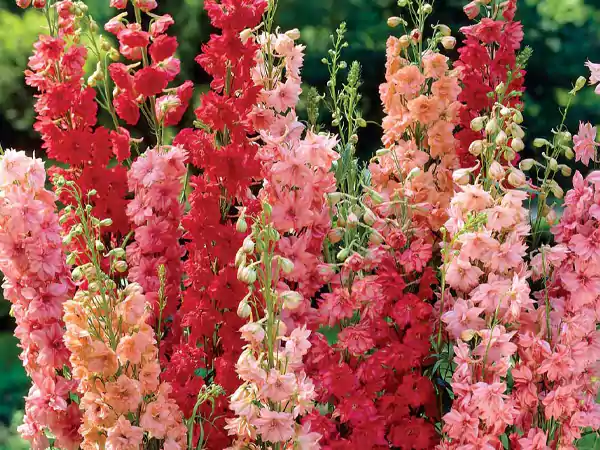
Trust me when I say this: Delphinium is one of the most eye-catching tropical flowers you can add to your summer garden. Widely appreciated for its tall, upright spikes packed with vibrant blooms, delphinium adds height, drama, and color to flower beds and borders.
Available in striking shades of blue, violet, pink, and white, this plant is truly a standout species in any landscape. Moving further, let us quickly explore some distinctive characteristics of the genus.
- Tall and Majestic Flowers: Adds dramatic height to the garden landscapes. These blooms reach up to a height of 3–6 feet or even more. When planted on the border of the patio, the Blue Delphinium tends to add structure to the garden.
- Color Variety: From royal blues and purples to soft pinks, whites, and even multicolored hybrids, delphiniums offer a dazzling range of colors. If you are planning to have a theme garden, this wide palette makes it a versatile choice.
- Pollinator Magnet: Delphinium flowers are a favorite among bees, butterflies, and hummingbirds. By planting them, you not only add beauty to your backyard but also support the local ecosystem by attracting pollinators that help other plants thrive.
- Cold-Loving Plants: Unlike many summer flowers, Delphinium flourishes in cooler climates, making it a great choice for gardens in temperate and cool zones, where it blooms with full zeal.
Being every gardener’s dream species, it is quite clear that this genus is simply more than just a pretty bloom. Delivering both beauty and purpose, once I added these to my front lawn, it was difficult not to fall in love with them.
Some Popular Delphinium Varieties
With so many cultivars available, choosing the right delphinium for your garden can be a challenging task. Below are some of the most loved varieties that are sure to impress you.
Delphinium “Black Knight”
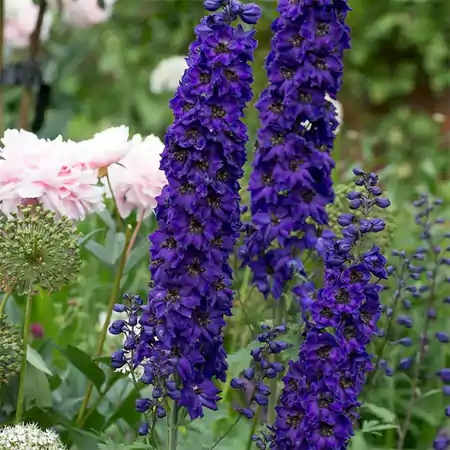
Commonly known as Candle Larkspur, the Delphinium Black Knight is usually planted to add a bold pop of color and structure to any landscape. This perennial bloom manages to become the eye-catching element in every garden space.
| Color: Deep Violet Blue |
| Height: 4–6 feet tall |
| Unique Feature: Intense color with contrasting dark centers. |
| Hardiness Zone: 3-7 USDA |
Delphinium ‘Pacific Giant’
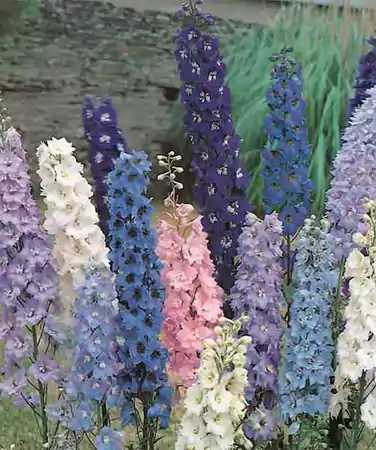
The Delphinium Pacific Giants are mainly planted as border cover flowers, and they instantly add an alluring vibe to the entire space. With multicolored upright spikes, this cultivar is the favorite among gardeners and novice plant lovers.
| Color: Mixed Shades |
| Height: Up to 6 feet (1.83 m) tall |
| Unique Feature: Classic tall spikes, mostly used for back borders. |
| Hardiness Zone: 3-8 USDA |
Delphinium ‘Blue Butterfly’
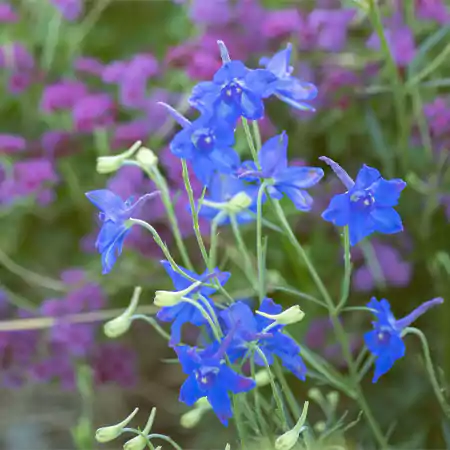
Commonly called Chinese Larkspur, the Delphinium Blue Butterfly is a short-lived perennial species that is mostly planted to create a color contrast in garden areas. These are usually grown in clusters and are also used to make bouquets.
| Color: Bright sky blue |
| Height: 12-24 inches tall |
| Unique Feature: Compact varieties, great for container planting. |
| Hardiness Zone: 3-7 USDA |
Delphinium ‘Astolat’
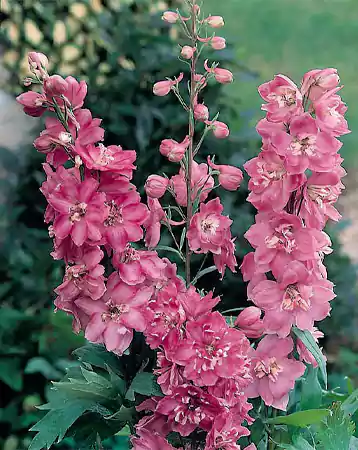
Belonging to the Pacific Giant family, the Delphinium Astolat is a tall, striking perennial known for its large and soft pink flowers. Typically, blooms in late spring or early summer, the species can reach up to a height of 4–5 feet.
| Color: Soft rose pink |
| Height: 4-5 feet tall |
| Unique Feature: Romantic color, perfect for cottage gardens. |
| Hardiness Zone: 3-7 USDA |
Delphinium ‘Guinevere’
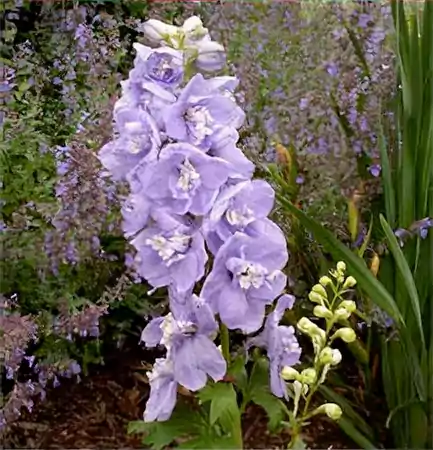
Known for its lavender-pink blooms with contrasting white centers, the Delphinium Guinevere is a tall perennial with striking, elegant flowers. These can be grown in pots and containers and are mostly used for cut flower arrangements.
| Color: Lilac with white cotton-like buds in the center. |
| Height: 4–5 feet tall |
| Unique Feature: Romantic color, perfect for cottage gardens. |
| Hardiness Zone: 3-7 USDA |
Delphinium ‘King Arthur’
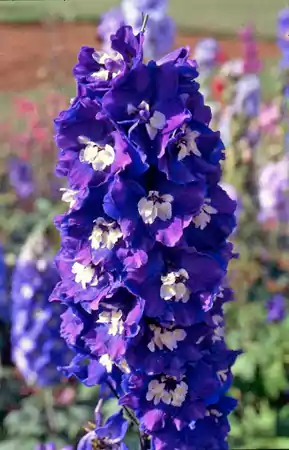
If you wish to add drama to your garden, this Delphinium cultivar is an excellent choice. Also known as King Arthur Larkspur, this genus features deep royal purple flowers with a tiny white flower in the center. Though the species is short-lived, it can tolerate a wide range of climatic conditions.
| Color: Purple and white mix blooms |
| Height: 5–6 feet tall |
| Unique Feature: Bold color contrast and dense flowering. |
| Hardiness Zone: 3-7 USDA |
Delphinium ‘Magic Fountains’
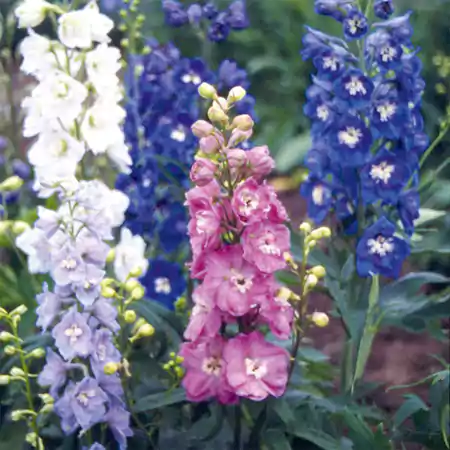
The Delphinium Magic Fountains are known for their semi-double flowers in shades of blue and purple. According to some gardeners, due to the compact size of this cultivar, these can also be grown indoors to enhance the aesthetics of any space.
| Color: Blue, pink, lavender blooms |
| Height: 30-36 inches tall |
| Unique Feature: Dwarf variety for small gardens. |
| Hardiness Zone: 3-7 USDA |
Delphinium Elatum
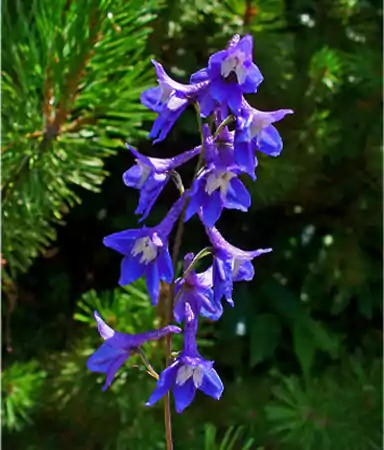
Native to the temperate regions of Europe and Asia, Delphinium Elatum is also known as Alpine Delphinium, Bee Larkspur, or Candle Larkspur. The genus is popularly known as a pollinator magnet, as it easily attracts hummingbirds and butterflies.
| Color: Varies widely |
| Height: up to 6 feet (1.83 m) tall |
| Unique Feature: Parent species of many hybrid varieties. |
| Hardiness Zone: 3-7 USDA |
Whether you are looking for a tall border showpiece or a charming container flower, there is a delphinium variety to fit every space and style.
Their striking hues and elegant form make them a garden favorite across the globe. I simply added the Blue Delphinium flower to my backyard, and now I have a collection of almost all the cultivars.
Taxonomic Overview of the Delphinium Flower
If you are a seasoned botanist or a garden enthusiast, understanding the scientific classification of the Blue Delphinium will help you gain knowledge about the botanical background of the species.
| Taxonomic Overview of Delphinium | |
| Kingdom | Plantae |
| Clade | Tracheophytes |
| Clade | Angiosperms |
| Clade | Eudicots |
| Order | Ranunculales |
| Family | Ranunculaceae |
| Subfamily | Ranunculoideae |
| Tribe | Delphinieae |
| Genus | Delphinium |
The Delphinium genus comprises around 300 species. Some flowering plants are annual, while others are perennial. If you are looking for a smart way to elevate the look of your front lawn, this alluring plant is your go-to option.
How to Grow and Care for the Blue Delphinium Flowers?
Delphiniums are known for their tall, majestic spikes and vibrant blooms, making them a stunning addition to any garden space. In order to truly enjoy the beauty of the genus, it is necessary to understand its care needs. Given below is the ultimate Delphinium care guide for your ease.
| Optimal Growing Conditions for the Delphinium Flowers | |
| Sunlight Exposure | Requires a minimum of 6–8 hours of direct sunlight. It can also be grown in areas having partial shade. |
| Water Requirement | Regular watering is needed, especially during the dry spell. Avoid overwatering to prevent fungal infections. |
| Soil Type | Grows well in permeable loamy soil having pH levels between 6.5–7.0. Consider adding compost to the soil to boost the growth of the plant. |
| Hardiness Zone | 3-9 USDA |
| Blooming Season | Early spring to late summer |
| Growth Rate | 1–2 feet per year |
| Mature Height and Width | 5-6 ft tall |
| Fertilizers | A balanced fertilizer in the ratio 10-10-10 works wonders. |
With just a bit of care and effort, the Blue Delphiniums can reward you with their alluring blooms, making a breathtaking floral display in your front lawn. Once you get sorted with their care guide, planting them becomes a joyful experience.
Common Pests and Diseases That Affect the Delphinium Blooms
Just like many other plants, these species also come with their own set of problems. When I was planning to sow the Delphinium Seeds in my backyard, I did thorough research on what could affect the growth of these stunning blooms. Knowing what to watch out for can help you catch concerns early and keep your plants blooming beautifully all season long.
| Pests and Diseases | Signs to Look For | Control Tips |
| Aphids | Sticky leaves, distorted growth, clusters on new shoots | Spray with neem oil or a mild soap solution. |
| Slugs and Snails | Tiny holes in leaves, slime trails | Hand-pick at night, use copper tape or slug pellets. |
| Spider Mites | Tiny webbing, yellowing, or fungal spots on leaves | Increase humidity and spray with an insecticidal solution. |
| Leaf Miners | Squiggly trails inside leaves | Remove affected leaves, and use neem oil regularly. |
| Caterpillars | Chewed leaves, visible larvae on stems | Hand remove or apply organic fertilizer. |
| Powdery Mildew | White, powdery coating on leaves and stems | Improve the airflow, avoid overhead watering, and use fungicides. |
| Crown Rot | Wilted, collapsed plant from the base | Improve drainage, remove and destroy the affected plant to prevent it from spreading. |
| Leaf Spot | Brown or black spots on the leaves | Remove the dead and damaged leaves and use a fungicidal spray. |
Although caring for Delphiniums is easy, with the right knowledge, you can stay one step ahead and prevent them from getting damaged by any kind of pests and diseases. I personally prefer doing regular inspections and try to maintain good spacing between each plant to prevent any disease from spreading.
Final Thoughts
To sum up, I must say that Delphiniums are simply beyond their beauty and striking appearance. With just a little care and attention, they can instantly elevate the look of any garden space. If you are planning to brighten up your entryway with year-long blooms, there is nothing better than these majestic blooms.
Once I understood the needs of the Delphinium flowers, it has always been a joy to grow them. Offering elegance and structure, these species have been an unforgettable addition to my garden space.
Do Delphiniums require sun or shade?
Delphiniums require a minimum of 4–6 hours of direct sunlight, but they can also thrive in areas having filtered light.
How toxic is Delphinium to humans?
All the parts of this species are toxic to humans, and if ingested, can cause digestive problems or nervous system diseases.
Do Delphiniums grow back every year?
Yes, these flowers are considered hardy perennials, as they manage to grow back every year.
How to keep Delphiniums blooming?
By following a simple care guide and providing the genus with basic growing conditions, you can witness a blooming Delphinium.
Will Delphinium rebloom if deadheaded?
Yes, deadheading is especially done to encourage new growth in any species.
Delphinium — NC State Extension


